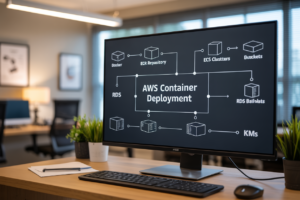In today’s data-driven world, the ability to store and manage vast amounts of information is not just a luxury—it’s a necessity. But as data grows exponentially, traditional storage solutions are buckling under the pressure. 🌐💾
Enter the realm of distributed file systems, the unsung heroes of cloud storage. These powerful systems are revolutionizing how we approach data storage, offering unprecedented scalability and flexibility. But designing a truly scalable cloud storage solution isn’t just about throwing more servers at the problem. It’s an art that requires a deep understanding of distributed systems, careful planning, and a host of considerations from consistency to security.
Are you ready to unlock the secrets of designing scalable cloud storage? Join us as we dive into the world of distributed file systems, exploring everything from the basics of scalability to advanced optimization techniques. Whether you’re a seasoned cloud architect or a curious tech enthusiast, this guide will equip you with the knowledge to tackle the challenges of modern data storage head-on. Let’s embark on this journey to master the art of cloud storage design!
Understanding Distributed File Systems
Key components of distributed file systems
Distributed file systems consist of several essential components that work together to provide scalable and reliable storage solutions:
- Metadata servers
- Storage nodes
- Client interfaces
- Network infrastructure
Here’s a breakdown of these components and their roles:
| Component | Role |
|---|---|
| Metadata servers | Manage file system structure, permissions, and file locations |
| Storage nodes | Store and retrieve actual data blocks |
| Client interfaces | Provide access to the file system for applications and users |
| Network infrastructure | Enable communication between components |
Benefits for cloud storage scalability
Distributed file systems offer numerous advantages for cloud storage scalability:
- Horizontal scalability: Easily add more storage nodes to increase capacity
- Load balancing: Distribute data and requests across multiple nodes
- Fault tolerance: Replicate data across nodes to prevent data loss
- High availability: Continue operations even if some nodes fail
- Improved performance: Parallel access to data from multiple nodes
Popular distributed file system technologies
Several distributed file system technologies are widely used in cloud environments:
- Hadoop Distributed File System (HDFS)
- GlusterFS
- Ceph
- Amazon Elastic File System (EFS)
- Google Cloud Filestore
These technologies offer various features and optimizations tailored to different use cases and scalability requirements. When designing scalable cloud storage solutions, it’s crucial to evaluate these options based on your specific needs and workload characteristics.
Designing for Scalability
Horizontal vs. vertical scaling strategies
When designing for scalability in distributed file systems, two primary strategies emerge: horizontal and vertical scaling. Let’s compare these approaches:
| Strategy | Description | Advantages | Disadvantages |
|---|---|---|---|
| Horizontal Scaling | Adding more machines to the system | – Easier to scale<br>- Better fault tolerance<br>- Cost-effective for large-scale growth | – More complex management<br>- Potential data consistency issues |
| Vertical Scaling | Upgrading existing hardware | – Simpler to implement<br>- Better for smaller-scale growth<br>- Maintains data locality | – Limited by hardware capacity<br>- Potential for single points of failure |
For cloud storage systems, a combination of both strategies often yields the best results, allowing for flexibility and optimal resource utilization.
Load balancing techniques
Effective load balancing is crucial for maintaining performance as the system scales. Common techniques include:
- Round-robin distribution
- Least connections method
- IP hash
- Weighted distribution based on server capacity
Implementing these techniques ensures even distribution of requests across the system, preventing bottlenecks and improving overall performance.
Data partitioning and sharding
Data partitioning involves dividing large datasets into smaller, more manageable pieces. Sharding takes this concept further by distributing these partitions across multiple servers. Key considerations include:
- Choosing an appropriate sharding key
- Implementing consistent hashing for even distribution
- Managing cross-shard operations efficiently
Replication and redundancy
To ensure data availability and fault tolerance, replication is essential. Common replication strategies include:
- Master-slave replication
- Multi-master replication
- Quorum-based systems
These approaches help maintain data consistency while providing redundancy against hardware failures or network issues. When combined with intelligent data placement algorithms, replication can significantly enhance the scalability and reliability of cloud storage systems.
Ensuring Data Consistency and Availability
CAP theorem and its implications
The CAP theorem is a fundamental concept in distributed systems, stating that it’s impossible for a distributed data store to simultaneously provide more than two out of three guarantees: Consistency, Availability, and Partition tolerance. This has significant implications for cloud storage design:
| Guarantee | Description | Trade-off |
|---|---|---|
| Consistency | All nodes see the same data at the same time | May sacrifice availability |
| Availability | Every request receives a response | May sacrifice consistency |
| Partition tolerance | System continues to function despite network partitions | Essential for distributed systems |
Cloud storage designers must carefully consider these trade-offs when architecting their systems. For instance:
- CP systems: Prioritize consistency and partition tolerance, potentially sacrificing availability during network partitions.
- AP systems: Focus on availability and partition tolerance, allowing temporary inconsistencies.
- CA systems: Emphasize consistency and availability but are impractical in distributed environments due to network partition risks.
Consistency models in distributed systems
Different consistency models offer varying degrees of data coherence across distributed nodes:
- Strong consistency: Ensures all replicas are identical at all times
- Eventual consistency: Allows temporary inconsistencies but guarantees convergence over time
- Causal consistency: Preserves cause-effect relationships between operations
- Read-your-writes consistency: Ensures users always see their own updates
Techniques for high availability
To maintain high availability in cloud storage systems:
- Implement redundancy through data replication
- Use load balancing to distribute traffic across multiple nodes
- Employ failover mechanisms to redirect requests during node failures
- Utilize distributed caching to reduce latency and improve responsiveness
Disaster recovery planning
Effective disaster recovery strategies for cloud storage include:
- Regular data backups across geographically diverse locations
- Implementing a robust Business Continuity Plan (BCP)
- Conducting periodic disaster recovery drills to test system resilience
- Employing multi-region deployments for enhanced fault tolerance
Now that we’ve covered data consistency and availability, let’s explore how to optimize performance in cloud storage systems.
Optimizing Performance
Caching strategies
Implementing effective caching strategies is crucial for optimizing performance in distributed file systems. Here are some key approaches:
- Client-side caching
- Server-side caching
- Distributed caching
| Caching Type | Description | Benefits |
|---|---|---|
| Client-side | Stores frequently accessed data on client devices | Reduces network traffic, faster access |
| Server-side | Caches data on storage servers | Improves overall system performance |
| Distributed | Utilizes a network of cache nodes | Enhances scalability and fault tolerance |
Data locality and access patterns
Understanding data locality and access patterns is essential for optimizing distributed file system performance. Consider:
- Placing related data on the same or nearby nodes
- Analyzing and predicting access patterns
- Implementing data replication strategies
Network optimization techniques
To enhance network performance in distributed file systems:
- Use load balancing to distribute traffic evenly
- Implement traffic prioritization for critical data
- Optimize data transfer protocols
- Employ compression techniques to reduce data size
I/O performance tuning
Improving I/O performance is crucial for overall system efficiency. Key strategies include:
- Utilizing solid-state drives (SSDs) for frequently accessed data
- Implementing parallel I/O operations
- Optimizing block sizes for specific workloads
- Employing write-back caching for improved write performance
By implementing these optimization techniques, you can significantly enhance the performance of your distributed file system, ensuring faster access times and improved overall efficiency. Next, we’ll explore the critical aspect of security considerations in cloud storage systems.
Security Considerations
Encryption at rest and in transit
When designing scalable cloud storage with distributed file systems, encryption is crucial for protecting sensitive data. Implement encryption at rest to secure data stored on disks and encryption in transit to safeguard data as it moves between nodes or to end-users.
- At rest encryption: Use AES-256 or similar algorithms
- In transit encryption: Employ TLS 1.3 or newer protocols
Here’s a comparison of encryption methods:
| Encryption Type | Protects Against | Implementation |
|---|---|---|
| At rest | Physical theft, unauthorized access | Full-disk encryption, file-level encryption |
| In transit | Man-in-the-middle attacks, eavesdropping | SSL/TLS, VPN |
Access control and authentication
Implement robust access control mechanisms and multi-factor authentication to ensure only authorized users can access the distributed file system.
- Role-based access control (RBAC)
- Multi-factor authentication (MFA)
- Single sign-on (SSO) integration
Compliance and regulatory requirements
Adhere to industry-specific regulations and compliance standards to ensure your distributed file system meets legal and security requirements.
- GDPR for EU data protection
- HIPAA for healthcare information
- PCI DSS for payment card data
Regularly audit your system to maintain compliance and update security measures as regulations evolve. Implement data retention policies and ensure proper data deletion procedures are in place to meet compliance requirements.
Next, we’ll explore the crucial aspects of monitoring and managing your distributed file system to ensure optimal performance and security.
Monitoring and Management
Key performance indicators for cloud storage
When monitoring and managing distributed file systems in cloud storage, it’s crucial to track key performance indicators (KPIs) that provide insights into system health and performance. Here are some essential KPIs to consider:
- Throughput: Measures the amount of data transferred per unit of time
- Latency: The time taken for data to travel from source to destination
- IOPS (Input/Output Operations Per Second): Indicates the system’s ability to handle read/write operations
- Storage utilization: Percentage of total storage capacity currently in use
- Data durability: Measure of data integrity and resistance to loss or corruption
- Availability: Percentage of time the system is operational and accessible
| KPI | Description | Importance |
|---|---|---|
| Throughput | Data transfer rate | Affects overall system performance |
| Latency | Data travel time | Impacts user experience and application responsiveness |
| IOPS | Read/write operation speed | Critical for high-performance applications |
| Storage utilization | Used storage capacity | Helps in capacity planning and resource allocation |
| Data durability | Data integrity measure | Ensures long-term data preservation |
| Availability | System uptime | Guarantees consistent access to data |
Tools for distributed system monitoring
Effective monitoring of distributed file systems requires robust tools that can handle the complexity and scale of cloud environments. Some popular monitoring tools include:
- Prometheus: Open-source monitoring and alerting toolkit
- Grafana: Visualization and analytics platform for metrics
- ELK Stack (Elasticsearch, Logstash, Kibana): Log management and analysis
- Nagios: Infrastructure monitoring and alerting system
- Zabbix: Enterprise-class monitoring solution for networks and applications
Automated scaling and self-healing mechanisms
To ensure optimal performance and reliability, implement automated scaling and self-healing mechanisms:
- Auto-scaling: Automatically adjust resources based on demand
- Load balancing: Distribute workload across multiple nodes
- Data replication: Maintain multiple copies of data for redundancy
- Failover mechanisms: Automatically switch to backup systems in case of failures
- Health checks: Regularly assess node health and trigger corrective actions
These mechanisms work together to maintain system stability and performance, reducing manual intervention and improving overall reliability.
Now that we’ve covered monitoring and management aspects, let’s explore cost optimization strategies for cloud storage solutions.
Cost Optimization
Storage tiering strategies
Storage tiering is a crucial cost optimization technique for cloud storage. By implementing a tiered storage approach, organizations can significantly reduce costs while maintaining performance and accessibility. Here’s a breakdown of common storage tiers:
| Tier | Description | Use Case | Cost |
|---|---|---|---|
| Hot | Frequently accessed data | Active projects, recent data | Highest |
| Warm | Occasionally accessed data | Quarterly reports, older projects | Medium |
| Cold | Rarely accessed data | Compliance records, archives | Low |
| Archive | Infrequently accessed data | Long-term retention, backups | Lowest |
To implement an effective storage tiering strategy:
- Analyze data access patterns
- Define clear policies for data classification
- Automate data movement between tiers
- Regularly review and adjust tiering rules
Data lifecycle management
Effective data lifecycle management is essential for optimizing cloud storage costs. By implementing a comprehensive lifecycle policy, you can ensure that data is stored in the most cost-effective tier throughout its lifespan.
Key components of data lifecycle management include:
- Data creation and ingestion
- Active use and processing
- Archiving and long-term retention
- Deletion and secure disposal
Capacity planning and forecasting
Accurate capacity planning and forecasting are crucial for avoiding overspending on cloud storage. To optimize costs:
- Monitor current usage patterns
- Analyze historical data growth trends
- Consider upcoming projects and data initiatives
- Use cloud provider tools for predictive analytics
- Implement auto-scaling policies to adjust capacity dynamically
By combining these cost optimization strategies, organizations can significantly reduce their cloud storage expenses while maintaining performance and reliability. Next, we’ll explore the importance of monitoring and management in maintaining an efficient and cost-effective cloud storage infrastructure.
Distributed file systems are the backbone of scalable cloud storage solutions, offering unparalleled flexibility and performance. By focusing on scalability, data consistency, and availability, organizations can build robust storage infrastructures that grow seamlessly with their needs. Optimizing performance, implementing strong security measures, and establishing effective monitoring and management practices are crucial steps in creating a reliable and efficient cloud storage system.
As businesses continue to generate and process vast amounts of data, the importance of well-designed cloud storage solutions cannot be overstated. By leveraging distributed file systems and adhering to best practices in scalability, security, and cost optimization, organizations can unlock the full potential of cloud storage. Embrace these principles to future-proof your data infrastructure and stay ahead in the rapidly evolving digital landscape.




















